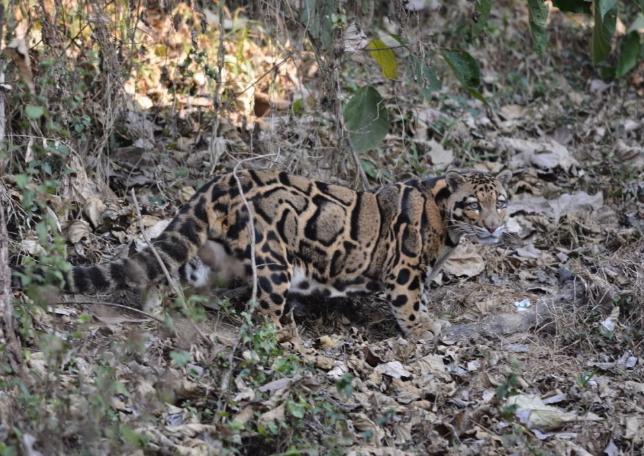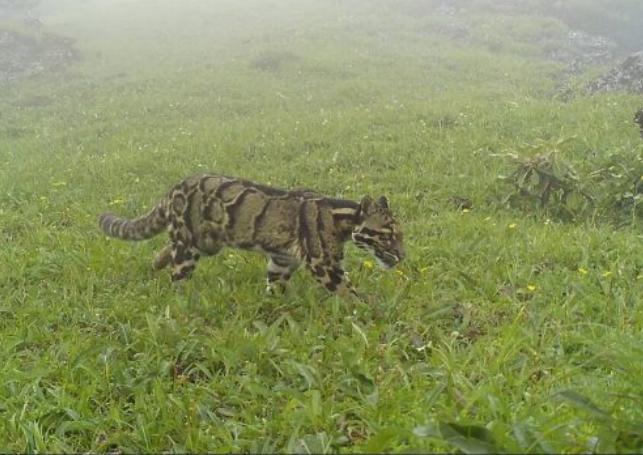Photographic evidence of elusive clouded leopard ((Neofelis nebulosa) has been recorded at an elevation of 3,700 meters not in a wildlife sanctuary but in a community-owned forest along the India-Myanmar border in the north eastern state of Nagaland. This rare species of leopard is listed as 'vulnerable' under the IUCN Red List of Threatened Species and its population is unknown in the wild. A team of researchers gathered evidence of four leopards- two adults and two cubs.
Found on the Highest Peak of Nagaland
The findings have been published in the winter 2021 issue of Cat News, the IUCN/Species Survival Commission (SSC) Cat Specialist Group’s biannual newsletter. The state animal of Meghalaya, the clouded leopard is a medium-sized felid (a mammal of the cat family), and is the smallest of the large wild cats. These leopards are largely known to inhabit low-elevation evergreen rainforests and are spread from the Himalayan foothills in Nepal, Bhutan and India to Myanmar, southeastern Bangladesh, Thailand, Peninsular Malaysia, to south of the Yangtze river in China. It is regionally extinct in Singapore and Taiwan.
Also read : Elusive Cats of Panna, As Threatened As The Park
The clouded leopard is one of the most talented climbers among the cats. Captive clouded leopards have been observed to climb down vertical tree trunks head first, and hang on to branches with their hind paws bent around branching of tree limbs. There are previous reports of the presence of clouded leopards at high elevations, but in national parks and state-protected areas, including Sikkim (3,720m), Bhutan (3,600m) and Nepal (3,140m). The fact that the Nagaland sighting is reported from a community forest reflect the fact that such areas, even if not protected by law, host a wealth of biodiversity.
Also read: Shhhh - Leopard is watching you
The team of researchers, led by the Delhi-based NGO Wildlife Protection Society of India (WPSI), recorded camera trap images of the species at 3,700m in the community forest of Thanamir village in the Kiphire district of eastern Nagaland . The forest, measuring 65 square kilometres, has Nagaland’s highest peak, Mount Saramati. A joint project of WPSI and Thanamir village , the research was an attempt to document the area’s biocultural diversity and also included a team of villagers from Thanamir. As many as 50 camera traps were placed in the forest — first between January-June 2020, and then between July-September 2021. “In total, we have evidence of at least two adults and two cubs. Images of two distinct individuals were captured with a camera placed above the tree line at 3,700 m close to the summit of Mt Saramati. Another individual was photo captured at 3,436m,” said a part of the peer-reviewed publication which was authored by Ramya Nair, Alemba Yimkhiung, Hankiumong Yimkhiung, Kiyanmong Yimkhiung, Yapmuli Yimkhiung, Toshi Wungtung, Avinash Basket and Sahil Nijhawan.
Also read: Midst Extinction Fear, Search Begins for Caracal in MP
The four leopards are residents of the area which indicates that there is enough prey and forest cover for them . Though little is known about the clouded leopards, they are usually found in tropical rainforests full of trees.But the four animals were found at a height on the mountain where the trees' growth end, the researchers have been quoted in media. The camera traps have also photographed Asiatic black bear, yellow throated marten, stump-tailed macaque, Assamese macaque as well as the Asiatic golden cat, marbled cat and leopard cat.Such a rich fauna is usually found in wildlife sanctuaries in India.
Clouded Leopard Skin Hangs in Kichen
Despite being a vulnerable species and protected by the law, the coat of a full-grown Clouded Leopard was found hanging inside a Naga kitchen, Conservation India reported in September 2011. “It was shot during the obligatory ‘no-hunting season’ by the village headman of Zipu village near Shatuza on the Indo-Myanmar border”, the report said. This image really captures how rampant hunting of even vulnerable species is in North-east India. Skins and skulls of various rarely seen species are part of common adornment in the kitchens' of many Naga tribes. In a biodiversity survey, students of National Centre for Biological Science found skulls of the extremely rare Leaf Deer (Muntiacus putaoensis) — only the second record from the country. The biodiversity of the Northeast is a genetic treasure of various forms of plants and animals. The region comes under the Indo-Burma biodiversity hotspot which ranks sixth among the 25 biodiversity hotspot of the world. Most of the North-Eastern states have more than 60% of their area under forest cover.There are 28 national parks and wildlife sanctuaries in North East including the world heritage sites like Kaziranga and Manas National parks and Pobitora wildlife sanctuary in Assam.




Comments
Post a Comment